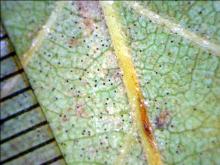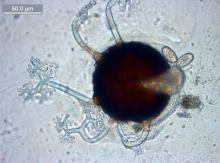Cause Erysiphe aggregata, Erysiphe penicillata (formerly Microsphaera penicillata), and Phyllactinia alnicola have been reported from the Pacific Northwest. Generally does not warrant control.
The conidia of these fungi are readily wind disseminated. Chasmothecia develop within the external hyphae and form appendages late in their development. The uneven wall thickness of P. alnicola and bulbous nature of the appendages allows for the entire cleistocarp to be dislodged from the host. When dry, the appendages flex like a spider's legs and allow the cleistocarp to be dislodged and carried by wind. These fungi may overwinter as chasmothecia or through buds infected the previous season.
Symptoms White powdery growth on either leaf surface and on catkins. Mycelial growth is sparse but dark, spherical chasmothecia are obvious, especially on the underside of leaves late in the growing season.
Cultural control
- Rake and destroy fallen leaves.
Chemical control Generally does not warrant control.
- Eagle 20 EW at 6 to 12 fl oz/100 gal water. Group 3 fungicide. 24-hr reentry.
- Myclobutanil 20 EW T&O at 6 to 12 fl oz/100 gal water plus spreading agent. May observe a PGR effect. Group 3 fungicide. 24-hr reentry.
- Myclotect at 6 to 12 fl oz/100 gal water plus spreading agent. May observe a PGR effect. Group 3 fungicide. 24-hr reentry.
- Spectracide Immunox Multi-Purpose Fungicide Spray Concentrate for Gardens at 1 fl oz/gal water. Group 3 fungicide. at 1 fl oz/gal water. H
Reference Shaw, C.G., and Harris, M.R. 1960. Important diseases and decays of trees native to Washington. Ag Extension Service, WSU. Extension Bulletin 540.



